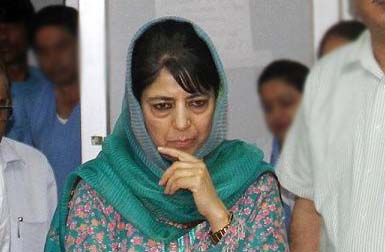By Masood Hussain

By the time, government spokesperson Naeem Akhter refused responding to any question by any reporter, one query had already been thrown: “When is your government resigning?”
But the question was rooted in history. On June 28, 2008 – the sixth day of the land row, Ms Mehbooba Mufti, withdrew the support to Ghulam Nabi Azad’s coalition government. By then three civilians were dead.
“We had requested the Chief Minister to revoke the order by June 30 but since situation is getting from bad to worse, we do not want to remain associated with the government,” Ms Mufti told a crowded news conference. “I told them that the situation is really grave and they should do whatever is needed but let us do what we think is demanded from us,” she said, “people are being killed and the situation is getting worse”.
That key decision helped PDP claim that they wanted to convey to Delhi that they cannot always decide which government should or should not be in place in Srinagar. It was part of the larger argument that it was keen to be Kashmir’s voice in Delhi and not vice-versa.
Ms Mufti and the PDP exhibited the same anger at the peak of 2009 tensions over the twin murders in Shopian. She personally led her party leaders in a curfewed Shopian at huge personal risk. And in 2010 unrest that eventually led to 122 killings, the party left nothing to represent the people.
With Ms Mufti leading the PDP-BJP alliance and the security-grid sending more than 1700 people to the hospitals in three days – of which 41 are dead and more than 10 highly critical, her opponent was more accommodative.
“Dear @MehboobaMufti We in @JKNC_ are always ready to contribute towards maintaining peace but you must take the lead & show the way,” Omar said in one tweet. “More than anyone else I know what you’re going through @MehboobaMufti & I can assure you that we will follow your lead but lead YOU must.”
There were jibes and critic but it never crossed a line. Though part of the reason could be that NC does not feel that PDP’s loss on ground can become its gain, the fact remains that Omar was not un-supportive. He told a TV channel that he would not accuse Ms Mufti for the flare-ups because these are routine in Kashmir.
Seemingly, PDP and BJP are enjoying the best of alliance. Ever since the crisis erupted, the only statement that could have been seen slightly getting off-track was that of Ram Madhav’s about “firmness of government, with or without eruption”.
He, however, corrected it later by supporting non-lethal methods for crisis-management. With chances of Ms Mufti even thinking of demitting office seemingly remote, coalition’s “non-lethal” systems have already pushed Kashmir to the lethal path. So what is the moral of the story, if any?
The main eruptions were from south, PDP’s main support base. In 2010, interestingly, Omar faced mainly music from Srinagar. Apparently, Ms Mufti has lost her “cutting edge distinction” and “moral high ground” within the unionist camp that she is more concerned on human rights. This ongoing crisis was a great balancer. The common refrain in hospitals is: Omar Abdullah government took three months in sending such a huge load to hospital as the incumbent sarkar did in three days! Though the distinction between the two is erased, situation has thrown up many questions for her.
She may get benefit of doubt in emergence of Burhan as a phenomenon but people ask how he was killed. Militant killings are a routine but the way a mob, six days after the encounter, decimated the entire housing cluster in Bamdoora where the “encounter” took place raises more questions. This raid led by masked people was almost akin to the raid on Srinagar’s sleaze queen’s home in old city in 2006, minutes before the sleuths were going to search for evidences.
And then the Chief Minister may have to respond to the rumours in official circles that state government was perhaps the last to be taken in loop. Some of her party leaders are talking tough.
The crisis has revived various issues that once were at the core of PDP’s loud-thinking. How can a government, by the way, permit its forces to attack injured-carrying ambulances? Two deaths have already been there. And when lethality of Kashmir’s non-lethal arsenal is already proved, why is inertia at display?
For every happening in Kashmir, the ‘white man’s baggage’ – the Kashmir issue, is directly or indirectly linked. There has neither been any effort to meaningfully engage Pakistan nor the people who are on the other side of Kashmir’s ideological divide. Pakistan has already activated its foreign office and is observing a day for Kashmir.
For a very long time now militancy is indicating a declining trend. If it is correct why the legal and physical infrastructure that Delhi built to counter insurgency is not exhibiting any change? In 2009, Kashmir had 258 garrisons. Six years later, it is less by 84 camps only, the government revealed recently. How many garrisons are required to catch 100 rebels or may be slightly more? People see strengthened garrisons as outposts of Disturbed Areas Act enjoying immunity under AFSPA for managing a “vanquished” Kashmir. In Bejbehara periphery, youth even bulldozed a camp into a playing field overnight. This is key to the underlying anger and the fierce death-wish that youth displayed in last one week while attacking the army and the paramilitary camps across Kashmir. Burhan’s killing was just a trigger.
The argument that whether or not Congress and BJP represent the same India that Hari Singh and Sheikh Abdullah acceded to, can be part of the ‘battle of ideas’. But right now, Ms Mufti must encourage her ally to address the challenges that the crisis exposed.
Kashmir is a human habitation and not a game reserve. Avoid living to the adage: conflicts consume its creations.














